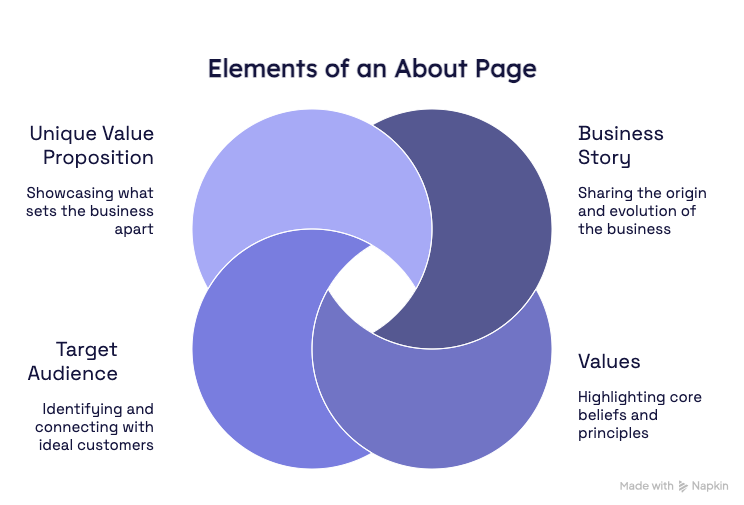Telling Your Story: How to Make Your About Page Stand Out
When someone visits your website, they’re usually trying to answer one important question: Can I trust this business?
Your About page is one of the first places they’ll look to find that answer. It’s where people go to get a sense of who you are, what you believe in, and what makes your business different. In many cases, it’s the page that turns a curious visitor into a loyal customer.
But too often, About pages are treated like an afterthought – just a quick bio or a few lines about the company’s history. That’s a missed opportunity.
Your About page is your chance to tell the story behind your business in a way that feels honest, clear, and worth remembering. In this guide, we’ll walk through how to write an About page that builds trust, shows personality, and connects with the people you’re trying to reach.
The Purpose of an About Page
Every page on your website has a job. Your homepage sets the tone, your service pages explain what you offer, and your contact page gives people a way to reach you. But your About page does something just as important: it introduces the people and purpose behind your brand. It gives shape to your identity and explains what your business stands for beyond the products or services you sell.
When someone clicks on your About page, they’re usually looking for answers that don’t show up anywhere else on your site. They want to know:
- Who’s behind this business?
- What kind of people are they?
- Why did they start this?
- Do they seem trustworthy?
- Do they understand the kind of person I am and what I care about?
Basically, this is where people try to figure out whether they feel good about choosing you.
More than anything, your About page humanizes your business. Today’s customers actively seek out brands that feel authentic and relatable. Psychology Today backs this up, noting that when people perceive a brand as genuine, they’re more likely to trust it, engage with it, and stay loyal over time.
That’s what makes the About page so valuable. This is your space to share what led you here, what you believe in, and how those beliefs show up in the work you do. It helps your audience feel like they’re not just buying something from a company; they’re supporting real people who care about what they do.
What to Include on Your About Page
There’s no single right way to write an About page, but there are a few important elements that help it do its job. The goal is to tell a clear, honest story that helps people understand who you are and why your business exists.
Here are the parts that matter most:

1. Tell the Story Behind Your Business
Your story is often the first thing people look for on an About page, and it’s usually what they remember most. This doesn’t need to be a dramatic origin tale; it just needs to feel real.
Start with the moment that pushed you to start your business. Maybe you noticed a gap in the market. Maybe you wanted more flexibility or purpose in your work. Maybe it started as a side project that grew over time. Whatever your path was, share it in a way that helps people understand your motivation.
Then, walk readers through a few key turning points. How has your business evolved? What have you learned along the way? What keeps you going now?
The goal here is to give enough context that people understand who you are, where you’re coming from, and why your business exists in the way it does. When your story feels personal and grounded, it builds connection – and that’s what turns a visitor into a potential customer.
2. Share What You Stand For
Once someone understands how your business started, the next question is usually: What do you believe in? This is where your mission and values come in.
Think about what matters most to you and how that shows up in your day-to-day. Are you focused on transparency? Do you prioritize community, creativity, or simplicity? What promises do you hold yourself to, even when things get busy?
According to a consumer study from IBM, 45% of consumers say they choose brands primarily based on how well those brands align with their personal values. That means your About page can directly influence whether someone decides to work with you or move on.
Instead of listing generic values like “excellence” or “integrity,” show what those ideas really look like in your business. For example:
- If you say you care about customer experience, explain how you go out of your way to support people after the sale.
- If sustainability is part of your brand, mention the choices you’ve made to reflect that, like your packaging, sourcing, or partnerships.
When you bring your values to life with real examples, it’s easier for someone to understand not just what you do, but what kind of experience they can expect.
3. Speak to the People You’re Trying to Reach
Once someone understands your story and your values, they want to know: Is this business for someone like me?
This is your chance to make that clear.
Think about your ideal customer or client. What are they dealing with when they land on your site? What are they hoping to find? What do they care about that you also care about? This doesn’t mean you need to write a long description of your target audience. It just means you should speak to them in a way that shows you understand where they’re coming from.
For example:
- If you work with local service-based businesses, say so.
- If you focus on helping people who are new to a certain industry, acknowledge that.
- If your customers tend to care deeply about design, sustainability, or efficiency, reflect that in your tone and examples.
A good About page makes the right people feel like they’re in the right place. And when someone sees themselves in your story, they’re more likely to stick around.
4. Show What Makes You Different
Lastly, your About page is a chance to explain why someone should choose you instead of a competitor. This is known as your unique value proposition (UVP): the specific way your business solves a problem, meets a need, or delivers something better than the alternatives.
Think about what people appreciate most after working with you. Is it your responsiveness? Your design style? Your ability to explain things in plain language? The personal attention you give? These are often the things that matter more than features or pricing, and they’re worth highlighting.
You don’t have to make a big pitch. A few simple lines that point to what makes your business different can go a long way. Here are some examples:
- “We’re a small team, which means you’ll always work directly with us, not get handed off to someone new.”
- “We combine design and strategy so your website not only looks great, but works hard behind the scenes.”
- “We’ve built our business on referrals, which means we focus more on relationships than ad spend.”
The goal is to help someone understand what it’s like to work with you and why that might be the right fit for them.
How to Make Your About Page Feel Personal
A lot of About pages end up sounding the same: too polished, too formal, or just too vague. And while it’s natural to want to sound professional, the most effective About pages read like they were written by a real person, not a marketing team.
Here are a few ways to make that happen:
- Write the way you speak. You don’t need fancy language or clever phrasing. Think about how you’d explain your story to a customer in conversation. That tone is usually the right one.
- Be transparent about the journey. Your story doesn’t need to be perfect. If things started off messy or evolved over time, say so. People connect with honesty more than polish.
- Skip the buzzwords. Generic phrases and jargon like “innovative solutions” or “customer-first approach” don’t say much. Use real language and give specific examples instead.
- Include something personal. A line or two about what motivates you, what you enjoy about the work, or even a small quirk or fun fact can go a long way. These details help your brand feel more human and more memorable.
You don’t have to try too hard. A little personality, a little honesty, and a clear explanation of who you are and why you do what you do is more than enough.
Simple Ways to Structure Your About Page for Clarity
Writing the content is one thing, but how you structure your About page plays a big role in whether people read it or leave. A clean structure helps people follow your story, pick out the information that matters to them, and stay engaged without feeling overwhelmed.
Here are a few ways to keep your page organized and easy to follow:
- Break it into sections. Use clear headings like “Our Story,” “Who We Help,” or “What We Believe” to guide the reader through the page. This makes the content easier to scan and keeps it from feeling like one long block of text.
- Use visuals where it makes sense. Photos of you or your team, your workspace, or even behind-the-scenes moments can help people feel more connected. A face or setting goes a long way in making your brand feel real.
- Put the most important info near the top. Not everyone will read the full page. Make sure your key message is clear within the first few lines.
- End with a strong call to action. What should someone do after reading your About page? Whether it’s booking a call, browsing services, or signing up for your newsletter, make the next step easy to find.
Your About page doesn’t need a fancy layout. Just a clear structure, some thoughtful visuals, and a message that’s easy to follow.
A Small Page with a Big Impact
If someone’s reading your About page, they’re already interested. What they’re looking for now is a reason to trust you.
This is your moment to connect – not by being perfect, but by being clear, honest, and human. A good About page won’t do the work of your whole website, but it can tip the balance. It can turn “maybe” into “this feels right.”
And if writing isn’t your thing, that’s okay. This is one of those parts of your website where getting it right can make a big difference. At Vervology, we help small businesses put their story into words in a way that feels true to who they are. If you’re ready to make your About page a stronger part of your brand, we’d love to help.


